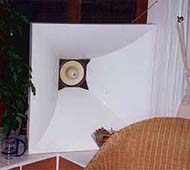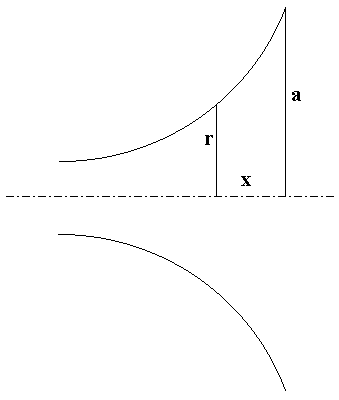Front Horn Design
This article describes a theory helping you to design your own front horn
Because speakers require air-contact (at wavelengths larger than the circumference of the moving diaphragm) to perform optimal it is likely that the horn-principle as used for the bass will benefit in the mid/low performance as well. This is something that spooked in my head for years already and is the reason why I developed a front horn for this area too for combining with my horn loaded bass design (my old friend the sub-horn who brings the best below 150 Hz and down!)

I have a great passion for wide-band systems. This because they don't used electronically filters. A simple coil already takes the life out of the musical performance. Add a capacitor and some other parts to eliminate things we don't want to hear (woofers seem to have some break-up problems we don't like or the tweeter resonances disturbs the filter-behavior) resulting in a system that measures perfectly but doesn't sound at all. Long ago I abandoned these multi-way systems and found my truth in wide-band systems.
My first wide-band was an electrostatic one, perfect ! The sound was clear, visible and wide! I listened to them with great pleasure until my dog decided to mark the things and caused their breakdown. Somehow I didn't mind because they started to annoy me for their size and the lack of sound-pressure. My wife didn't mind, she was happy that these monsters (2 meters high) had left the living-room!
The next system had to be smaller and still WITHOUT any filters.
The choice fell upon a minuscule wide-band speaker (Jordan JX-51) which because of its size needed some help from, of course, a horn. This system didn't enjoy a long life, I couldn't bear it's resonance around 2500 Hz for a long time. It did have something special though, spacial, open and very musical.
After that a while nothing, I played with some ideas, but all that changed when I noticed Lowther. I had heard of them, but never thought about them as really being of any interest. Why bother about something antique. All these old full-range drivers (such as Philips made them) they only yell at you. The modern speakers are much better, aren't they? My prejudice was there, these are not my speakers !
One day I was called by Victor Meurisse, a guy who was the chairman of the Lowther Club of Belgium. He had heard about the A.V.M.N. and would like to demonstrate his equipment to us. He was really enthusiastic about his Lowther speakers and horns. My curiosity grew with the minute, could it be possible that I stumbled into something worth while after all...?
The specs I received from Victor boosted by enthusiasm. Theoretically this would be the ideal speaker unit. Very fast, impulsive and wide-band enough to be used in a horn (front...). Actually, that was what I was looking for all that time. Added to all this the high sensitivity making it possible to use a 'simple' tube amplifier. Everybody is talking about single-ended these days, don't they?
The only disadvantage of this type amplification is their low output. Modern speakers with their in common low sensitivity are not easy to drive with these amplifiers. A Lowther driver with an sensitivity of 98 dB should not give any problem, especially since tube amplifiers are not fond of funny capacities or inductions at their output. So the Lowther has a lot of advantages, but how would they sound ?
The Lowther Club came for a demo and with the advantage of helping installing the equipment, I could see more and by asking I learned about everything I wanted to know. Listening up front proved to be an advantage too.
First you find yourself an ideal spot, CD of your own choice into the player, nice volume level and then sit back and listen. I was curious already but after each play I became more curious. What a detail and space. I wasn't used to this at all, never knew there was so much information on a CD. And the dynamics....now I knew for sure and understood Victors' enthusiasm, I will want to have these speakers!
After a delivery time of 3 weeks (it turned out to be 6) I unpacked my speakers at home and see what they look like. I had ordered the PM2A-silver because the magnet of this driver would theoretically be wide-banded enough to fit into my front horn design. I had rather ordered the PM5A or even the PM4A but they didn't fit my budget. The PM2A is not exactly cheap, but did meet my budget. The units were looking good with their huge magnet!
The design:
The cabinet I developed for the Lowther was of course a horn, a front-horn with the throat in front of the driver and not like many other designs at the rear. Placed in front of the speaker makes the sound come from one spot, the interference from different sources (like with rear loaded horns) is not present and the sound-color is the same over the complete frequency-range! An additional advantage is that the output at listening-position is minimal 6 dB higher plus gaining more body in the low-mids!
The shape is the most important issue for a good sounding front-horn. The formulas for low frequency exponential or hyperbolic horns supplied in previous articles cannot be used here, one would get a horn too long with a wrong curve which would result in a real "horny" sound, which is hardly HiFi. For low frequencies this is not a problem, since the wavelength will never fit the horn mouth. The moment the wavelength gets shorter than the diameter of the horn mouth, coloring will be caused due reflections. People who are prejudice to horns often have been listening to wrong designed horns who color the sound.
While waiting for my Lowthers' delivery I started with designing the horns. The throat needs to have the same diameter as the diaphragm surface. In this case Ah became 256 cm². The horn mouth Am had to have a surface enabling the horn to work from 150 Hz up. For this I used the following formula:

Which resulted in a surface of 65 x 65 cm. I reduced the size to 62 x 62 cm since the horn was to be placed in a corner where the walls act as extension of the horn. The ideal curve for midrange horns is the Tractrix cure with the equation as follows:

Where x is the centerline of the horn measured from the horn mouth, a is the radius of the horn mouth and r the radius to distance x. The outcome is valid for a circular horn but simply to transfer to a square model. The next drawing will make it clear.

After the calculation and made drawings it was time to get some material in order to bring things to life. With some effort resulting in two friendly horns looking at me from the corners of my room.
The results:
Next part was to mount the speakers in their new home, connected the wire to the amp, CD with my most favorite track in the player and........ my God, what a dreadful sound, cold, naked and grainy. This was quite a shock! After a while I realized how Victor told me that Lowther speakers need at least 500 hours to loosen up. Even so that they are not really suitable to drive by transistor amplifiers because they don't have to really work. Voltage regulators have a similar problem, a 1 Amp type cannot regulate 2 mA properly, a 100 mA variety here does a far more better job! OK, everything was new and I had my transistor, but this is not what I expected.
Lucky for me there is this friend who shops around, designs and builds tube amplifiers with all kinds of different tubes. I knew that he already had build some 30 tube-amps. In the past I did asked him to build me a tube-amp, but he refused, in spite of my quality to get people to do things for me. OK, I respected his point of view but he lent me one to play with. Great!
Back home and connecting the amp and listen again... that was quite a range better, the naked sound remained for a while, the grainy sound was highly reduced, the cold sound vanished during the days that came. After one week the sound balance was much better and I started to enjoy listening to music again.
I will not use the Transistor anymore, I borrowed the tube-amp for a little longer.... My future plan was to get a tube-amp (single-ended) anyhow, but this situation forced me to speed up things. After a market-scan I stumbled across one I could use for a few weeks, the nice owner went on holiday and so I could watch and use his stuff. It was a single-ended design with C-core OT's and 2A3 tubes. It showed some hum, but with the help of again a friend this problem was soon solved.
It makes a great difference listening to a tube-design without any kind of feedback. These 2A3's sound warmer and clearer, surprisingly open. My own amp will be a single-ended one, probably the one with the 2A3, because since I have heard it I don't want anything else anymore. It only delivers 3 Watts but for the Lowther it makes no difference. With only 1 Watt I can hear my neighbors complaining!
I have been listening to my new set-up for a month and there is actually nothing more to tell. The experimental horns will in time be replaced by more sophisticated ones, the borrowed amp will be returned to its rightful owner after I built my 2A3. Every time I sit down and listen I get carried away by the music, which gets more important to me every day. It does not matter what I play, nothing disturbs, crackles or does not sound well. Everything remains, no matter how loud I play!
Sometimes I wonder what we are really doing, I now listen to almost antique designs (speakers, cabinet, amp) out of the 20-thies . Why does this sound so much better than all these new 'improved' developments?
My Sources:
Design Factors in Horn-Type Speakers. Daniel J.Plach (October 1953) from "An anthology of articles on loudspeakers from the pages of the journal of the Audio Engineering Society".
Low-Frequency Horn Design using Thiele/Small driver parameters. D.B.Keele jr.. Preprint of the Audio Engineering Society.